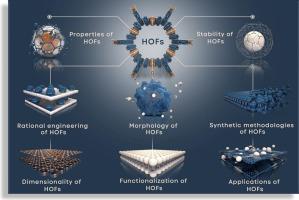在氢键有机框架的合成、功能化、形态、性质和应用方面取得了新的突破
IF 22
1区 材料科学
Q1 MATERIALS SCIENCE, MULTIDISCIPLINARY
引用次数: 0
摘要
氢键有机框架(hof)是一种多孔晶体材料,由于其优异的结晶度、溶液可加工性和易于再生,使其非常适合于多功能应用。尽管有这些优点,但一些hof在脱溶后变得不稳定,这给稳定性、孔隙度和功能化带来了挑战。最近的进展通过诸如更强的电荷辅助氢键和配位键等策略增强了hof的稳定性,从而导致更坚固的复合hof,包括离子和金属类型。本研究探讨了hof发展所需的基本设计概念和化学合成,重点关注其从一维(1D)到三维(3D)设计的结构变化。它提供了详细的探索HOFs的性质,包括发光,磁性,机械强度,介电特性,客体交换,吸附,以及电子和光学特性。该综述还涵盖了一系列综合方法,每种方法都为定制hof结构和功能提供了独特的好处。π-π相互作用、结构集成、静电相互作用和共价键在增强结构完整性、弹性和稳定性方面的作用在提高HOFs稳定性的关键策略的详细讨论中得到了强调。此外,首次探索了包含各种化学基团的多种功能化策略,展示了它们如何修改和扩展hof的性质。最后,综述了不同的hof形态,包括薄膜、纳米片、纳米球和纳米管,以及它们在电池、膜、传感器、分离技术、超级电容器、二氧化碳捕获、电催化剂、光催化剂、质子电导率和生物应用等领域的广泛应用。在这篇综述中,我们的目标是提供一个全面的平台,涵盖了hof的各个方面,特别是突出了各种不同的功能单元和维度。这一详细的研究为读者提供了对hof的特征和可能用途的深入理解,使我们的审查通过其广泛的广度和彻底的分析而与众不同。这一全面的概述说明了hof在推进各种技术和科学领域方面的巨大潜力。本文章由计算机程序翻译,如有差异,请以英文原文为准。

Novel breakthrough in the synthesis, functionalization, morphology, properties, and applications of hydrogen-bonded organic frameworks
Hydrogen-bonded organic frameworks (HOFs) are porous crystalline materials due to their excellent crystallinity, solution processability, and ease of regeneration, making them well-suited for multifunctional applications. Despite these advantages, some HOFs become unstable after desolvation, presenting challenges related to stability, porosity, and functionalization. Recent advancements have enhanced HOFs stability through strategies like stronger charge-assisted hydrogen bonds and coordination bonds, leading to more robust composite HOFs, including ionic and metal types. The present study examines the fundamental design concepts and chemical synthons necessary for the development of HOFs, focussing on their structural variety from one-dimensional (1D) to three-dimensional (3D) designs. It provides a detailed exploration of HOFs properties, including luminescence, magnetism, mechanical strength, dielectric characteristics, guest exchange, adsorption, and electronic and optical features. The review also covers a range of synthesis methodologies, each offering unique benefits for tailoring HOFs structures and functionalities. The role of π-π interactions, structural integration, electrostatic interactions, and covalent bonding in enhancing structural integrity, resilience, and stability is highlighted in the detailed discussion of key strategies for increasing the stability of HOFs. Additionally, diverse functionalization strategies incorporating various chemical groups are explored for the first time, showing how they can modify and expand HOFs properties. Finally, the review addresses different HOFs morphologies, including thin films, nanosheets, nanospheres, and nanotubes, and their broad applications in fields such as batteries, membranes, sensors, separation technologies, supercapacitors, carbon dioxide capture, electrocatalysts, photocatalysts, proton conductivity, and biological applications. In this review, we aim to provide a comprehensive platform that covers all aspects of HOFs, especially highlighting a wide range of different functionality units and dimensionality. This detailed examination provides readers with an in-depth comprehension of the characteristics and possible uses of HOFs, setting our review distinct via its wide-ranging breadth and thorough analysis. This comprehensive overview illustrates the significant potential of HOFs to advance various technological and scientific domains.
求助全文
通过发布文献求助,成功后即可免费获取论文全文。
去求助
来源期刊

Materials Today
工程技术-材料科学:综合
CiteScore
36.30
自引率
1.20%
发文量
237
审稿时长
23 days
期刊介绍:
Materials Today is the leading journal in the Materials Today family, focusing on the latest and most impactful work in the materials science community. With a reputation for excellence in news and reviews, the journal has now expanded its coverage to include original research and aims to be at the forefront of the field.
We welcome comprehensive articles, short communications, and review articles from established leaders in the rapidly evolving fields of materials science and related disciplines. We strive to provide authors with rigorous peer review, fast publication, and maximum exposure for their work. While we only accept the most significant manuscripts, our speedy evaluation process ensures that there are no unnecessary publication delays.
 求助内容:
求助内容: 应助结果提醒方式:
应助结果提醒方式:


